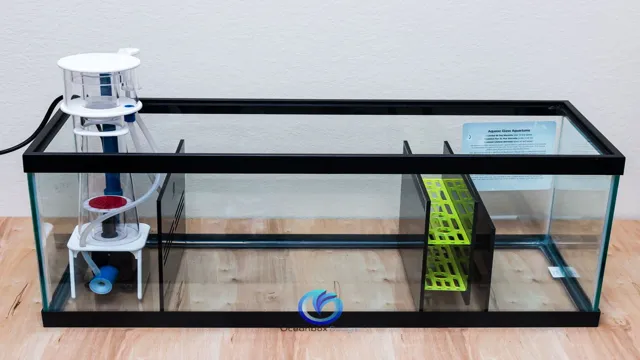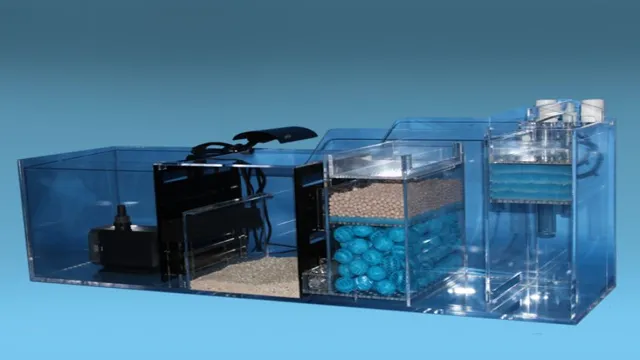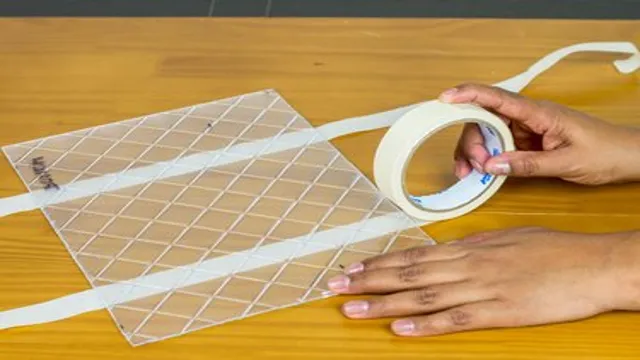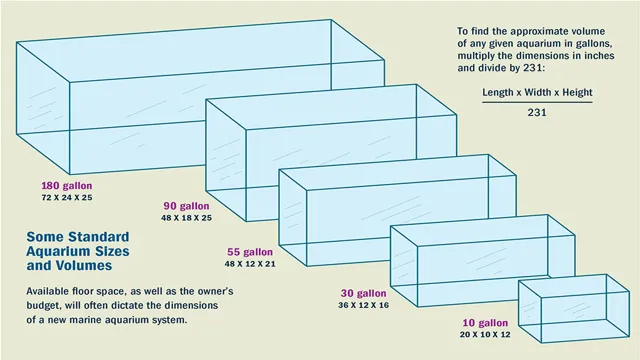Building a reef aquarium sump is a rewarding DIY project that can enhance the performance and appearance of your saltwater aquarium. A sump is essentially an additional tank that sits below the main tank and holds various equipment that helps filter and circulate water. It serves as a place to house your protein skimmer, heater, and other equipment that would otherwise take up valuable space inside the main tank.
The sump also provides a space for extra water volume, which helps to stabilize the conditions in your tank. But the question remains, how do you build a reef aquarium sump? In this blog, we’ll dive into the details of what you’ll need and the step-by-step process of building a sump for your reef aquarium. So, grab your tools, roll up your sleeves, and let’s get started!
What is a Sump and Why Use One?
If you’re new to the world of reef aquariums, you might be wondering what a sump is and why you would need one. Essentially, a sump is an additional tank that sits beneath your main aquarium and is used to house equipment such as a skimmer, heater, and possibly a refugium. There are a number of benefits to using a sump with your reef aquarium, including increased water volume, improved water quality, and easier maintenance.
By increasing the water volume, a sump can help to stabilize the temperature and salinity of your aquarium, reducing stress on your fish and corals. Additionally, a sump can help to remove excess waste through the use of a protein skimmer, while a refugium can provide a natural filtration system by growing beneficial algae and microorganisms. Overall, investing in a sump system can help to take your reef aquarium to the next level, providing a more stable and healthy environment for your marine life to thrive.
If you’re looking to build your own sump, be sure to do your research and work with a qualified professional to ensure that you create a system that meets your specific needs.
Definition of a Sump
A sump is a crucial component in many homes and buildings that helps remove excess water from areas that may flood or become damaged. It is essentially a pit or tank that collects water and other liquids and pumps them away from the property. So, why use a sump? Well, the answer is simple – to prevent water damage.
If you live in an area prone to heavy rain or flooding, having a sump pump installed can help mitigate the risks of water damage to your home. Additionally, a sump pump can aid in maintaining the structural integrity of your foundation by preventing water from seeping in and causing cracks or other forms of damage. A properly working sump pump is a valuable investment that can save you a ton of money in repairs and replacements if there is ever a water emergency in your home.
Overall, a sump pump is an excellent precautionary measure that every homeowner should consider.

Advantages of Using a Sump in a Reef Aquarium
A sump is an additional tank that works alongside your main display tank, designed to provide extra filtration, water flow, and oxygenation for your reef aquarium. Using a sump has several advantages for your reef aquarium. Firstly, it can help keep your display tank free of unsightly equipment such as heaters and protein skimmers.
Secondly, a sump allows for the addition of more filtration media, which can improve water quality and remove harmful toxins. Additionally, it can create a more stable water environment by increasing the volume of water in the system and providing a more robust biological filtration process. Overall, using a sump in your reef aquarium provides several benefits that can enhance your aquarium’s health and beauty.
Designing Your Sump
If you are wondering how to build a reef aquarium sump, then you are in the right place. A sump is an essential component of a reef aquarium as it provides additional filtration, oxygenation, and water volume for your fish and coral. To design your sump, you need to consider factors such as the size of your tank, the types of marine life you intend to keep, and your budget.
A common approach to sump design is to have three chambers: a protein skimmer chamber, a refugium chamber, and a return pump chamber. The protein skimmer chamber is where you place your protein skimmer, which removes organic waste from the water. The refugium chamber is where you can grow algae or other microorganisms that will help in nutrient removal, while the return pump chamber is where you place your return pump to transfer water back to your tank. (See Also: How Old Is the Belle Isle Aquarium Electric Eel and Its Lifespan: Explained)
Ensure that the sump’s dimensions are appropriate for your tank’s stand and plumbing. With adequate research and planning, the perfect sump for your reef aquarium is just a design away.
Determining the Size of Your Sump
When designing your sump, it is crucial to determine the appropriate size. The size of your sump will depend on a variety of factors, including your aquarium size, the equipment you use, and your desired water volume. A good rule of thumb is to have a sump that is at least one-third the size of your total water volume.
This will provide enough space for your equipment, including a skimmer, heater, and return pump, while also allowing for proper water flow. Additionally, consider the height and width of your sump to ensure it will fit comfortably in your stand and allow for easy maintenance. By carefully designing your sump, you can ensure optimal performance and a healthy environment for your aquatic inhabitants.
Parts of a Sump (Baffles, Skimmer Compartment, Return Pump, etc.)
Designing Your Sump When it comes to designing your sump, there are a few important factors to consider. One of the most important parts of a sump is the baffles, which help create a flow pattern for your water and separate different compartments from one another. The skimmer compartment is another important part of a sump, where you can place your protein skimmer to help remove waste from your water.
Additionally, you’ll need a return pump to send water back up to your display tank. Other components to consider include an area to add chemical media, such as carbon or GFO, and space for a heater or other equipment. When designing your sump, it’s important to think about how much space you have available and what your specific needs are.
Do you need a larger skimmer compartment or additional space for chemical media? Do you want to include a refugium for your macroalgae or live rock? Once you have a clear idea of what you need, you can start sketching out the basic layout of your sump and considering the size and placement of each component. Building your own sump can be a great DIY project for aquarists who want more control over their filtration system. With careful planning and attention to detail, you can create a customized sump that meets the specific needs of your aquarium.
Just remember to take your time and do your research to ensure that your sump is designed to work efficiently and effectively for your setup.
Choosing the Right Materials
When designing your sump, selecting the right materials is crucial. You want to pick materials that will stand the test of time and maintain their integrity in the face of constant water exposure. First and foremost, your sump needs to be made of material that won’t rust or corrode, as these can contaminate the water and cause damage to your equipment.
Stainless steel is a popular choice for sump construction since it’s highly durable, resistant to corrosion, and won’t rust even in salty water. Additionally, plastic is another popular material choice due to its affordability and chemical-resistant properties. Ultimately, selecting a quality material that will last for years is paramount in ensuring that your sump provides reliable function for your aquarium or aquatic system.
Building Your Sump
If you’re a reef aquarium keeper looking to build your sump, you’re in the right place! First things first, you’ll want to consider the size of your sump and the materials you’ll need for construction. You can use either acrylic or glass for your tank and refer to online calculators for determining the right dimensions to accommodate your specific tank setup. Once you have the materials, you’ll need to drill holes for your pipes and install a baffle system to filter out debris and keep water flowing correctly. (See Also: How to Clean Fish Aquarium Decorations: A Step-by-Step Guide)
Make sure to use silicone sealant to secure the baffles and check for any leaks before adding water. A sump can be an excellent addition to your reef aquarium setup, providing additional filtration and space for equipment. With the right planning and materials, building your sump can be a rewarding DIY project.
Step-by-Step Instructions on Assembly
If you’re looking to build your own sump, the first thing you’ll need to do is gather your materials. You’ll need a glass aquarium, a sump pump, PVC pipe, fittings, and silicone sealant. Once you have everything you need, it’s time to start assembling your sump.
Start by measuring and cutting the PVC pipe to the appropriate lengths, then use the fittings to attach the pipe to the aquarium. Be sure to securely attach the sump pump to the bottom of the aquarium, as this will be responsible for moving water through the system. Once everything is in place, seal all joints and seams with silicone sealant to prevent any leaks.
It’s important to take your time during the assembly process to ensure everything is properly secured and sealed. Remember, this is an important piece of equipment for your aquarium, so it’s worth investing the time to do it right. With a little patience and some careful planning, you’ll have a fully functional sump in no time.
Tips for Sealing and Leak Prevention
When building a sump, it’s important to ensure that it’s properly sealed to prevent leaks. A great tip for sealing your sump is to use silicone sealant on all the joints and connections. This will create a watertight seal that can withstand the constant exposure to water.
Another essential precaution is to check the placement of the sump pump and make sure that it’s secure. If the pump is not secured, it can move around and cause the plumbing connections to loosen or break. Burst pipes can lead to a lot of damage and downtime.
Additionally, it’s crucial to use the correct size PVC piping for the sump system. Using too small of piping can cause it to burst, while using too large of piping can lead to slow water flow. Be sure to follow the manufacturer’s instructions when setting up your sump to guarantee a properly functioning system that’s free of leaks and other plumbing issues.
Installing Your Sump
Ready to build your own reef aquarium sump but not sure where to start? Installing a sump system is a crucial part of building a healthy environment for your reef inhabitants. First and foremost, you’ll need to figure out the right size of your sump and locate the space to install it. Once you’ve determined these factors, you can then begin the installation process.
Start by drilling the necessary holes for pipes and positioning your return pump and protein skimmer. Make sure to aim for a tidy and organized setup, as this will ensure optimal performance and easy maintenance down the road. Finally, test run the system to check for leaks and ensure everything is running as smoothly as possible.
By taking these steps, you’ll be one step closer to having the perfect reef aquarium setup for your underwater friends to thrive in.
Plumbing Your Sump into Your Reef Aquarium
If you’re setting up a reef aquarium, installing a sump is crucial for maintaining a healthy environment for your fish and corals. However, plumbing it in can seem daunting. The first step is to choose the best location for your sump, keeping in mind accessibility for maintenance and water changes. (See Also: How to Bring Down Nitrate in Freshwater Aquarium: Best Ways)
Next, you’ll need to gather the necessary plumbing material such as PVC pipes, elbows, and valves. It’s important to measure accurately and plan out your plumbing system before beginning installation. Once you have everything ready, carefully attach the pipes and create a gap-free seal with PVC cement.
Test for leaks before filling up your sump and connecting it to your main tank. With proper installation and maintenance, your sump will ensure optimal water quality and a thriving reef ecosystem.
Start-up and Maintenance of Your Sump
Installing your sump is a crucial step in ensuring that your basement or crawl space is protected from water damage. Here are the steps you need to follow to install your sump correctly. Firstly, choose a location for your sump where water tends to accumulate.
Dig a hole that is deep enough to accommodate your sump basin, making sure that the top of the basin is level with the basement or crawl space floor. Secondly, connect the discharge pipe to the sump pump and place the pump inside the basin. Attach the check valve to the end of the discharge pipe to prevent water from flowing back into the basin, and then connect the PVC pipe to the check valve.
Lastly, install a cover over the sump basin to prevent debris from falling in and causing clogs. Once all these steps have been completed, test the system before use to ensure that everything is functioning correctly. It is essential to make sure that the sump is correctly installed before a rainy season or heavy snowfall to provide your home with maximum protection.
Conclusion and Final Thoughts
So, there you have it – the ultimate guide to building your own reef aquarium sump! With a little bit of knowledge, some creativity, and a few basic tools, you can create a sump that fits your specific tank needs and helps keep your underwater world thriving. It’s time to dive in and get building – who knows what kind of aquatic life you’ll discover in your creation. So go forth, reef enthusiasts, and take the plunge into the wonderful world of sump building!”
FAQs
1. What is a reef aquarium sump and why is it important for a successful reef tank? A: A reef aquarium sump is an additional aquarium that is typically placed beneath the main display tank, which helps to provide additional filtration, water circulation, and overall system stability. Sumps are important in reef tanks as they can help to remove harmful waste and debris from the water as well as provide a place for protein skimmers, return pumps, and other filtration equipment to be housed. 2. How do I select the right size sump for my reef tank? A: The size of the sump you need will depend on the size of your tank and the type and amount of equipment you plan to install. A good rule of thumb is to select a sump that is at least 10-20% of the total system volume (including the main display tank) to ensure adequate water volume and filtration capacity. 3. What types of equipment should I install in my reef aquarium sump? A: The specific equipment you need will depend on the needs of your tank, but most reef aquarium sumps will include a protein skimmer, return pump, and mechanical filter media such as filter socks or filter pads. Some hobbyists may also choose to install additional equipment such as heaters, reactors, or refugiums in their sump. 4. Can I build my own reef aquarium sump, or should I purchase one? A: Both options are possible, but building a sump yourself may require some DIY skills and familiarity with plumbing and aquarium equipment. If you’re a beginner or unsure about building your own sump, it may be easier to purchase a pre-made model from a reputable aquarium equipment supplier. 5. How do I properly install and maintain my reef aquarium sump? A: Proper installation of a reef aquarium sump involves ensuring proper plumbing connections, water level adjustments, and equipment setup. Regular maintenance of your sump will also be necessary to ensure that all equipment is working properly and that any mechanical filter media or other components are replaced or cleaned as needed. 6. What are some common problems associated with reef aquarium sumps, and how can I avoid them? A: Some common problems with reef aquarium sumps include leaks, improper water flow, and insufficient filtration or water turnover. To avoid these issues, it’s important to ensure that your sump is properly sized, installed, and maintained, and that equipment is selected and placed in the sump in a way that promotes good water flow and circulation. 7. Are there any alternative filtration options to using a reef aquarium sump? A: Yes, there are several alternative options for filtration in reef tanks that do not require the use of a sump. These can include hang-on-back (HOB) filters, canister filters, or all-in-one (AIO) tanks that include built-in filtration and equipment. However, sumps remain one of the most popular and effective options for larger reef tanks, as they provide ample space for equipment and are highly customizable to meet the needs of individual hobbyists.







